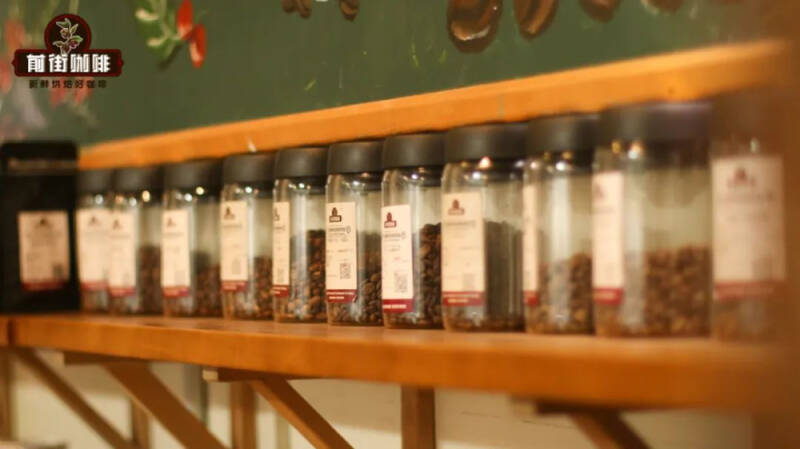What is the underlying logic of Italian blending, coffee bean blending idea? Can you make coffee by hand?
Recently, more and more friends have asked about Qianjie's matching ideas, and there are mainly two types of friends who like to make by hand, who have tasted conventional beans too many times and want to find some different fresh experiences. one kind of friends are fond of Italian style, want to develop their own blended coffee ~ so, Qianjie today to share the idea of coffee blending!

What is matching? The blending of coffee, as the name suggests, is made up of different beans to form a brand new bean. In the past, people blended beans for several purposes: first, in order to have a stable flavor formula, by putting several different coffee beans together, diluting the importance of each coffee bean! Because coffee beans are agricultural products, every year new beans will be affected by the climate of the year to produce a slightly different taste! When one of the coffee beans is out of stock or does not meet the taste requirements, people can replace it with another coffee bean!

Second, in order to reduce the cost, when the importance of each bean is reduced, then even if a small amount of poor quality and low price beans are mixed with deep baking, it is difficult for people to drink the difference in quality, thus reducing the cost! And this is the main reason why the match is not as good as the stereotype of SOE. But with the popularity of boutique coffee, people are no longer limited to cost control, more like the beginning, want to superimpose advantages, to create a new flavor to satisfy their stomachs! Can be spelled for Italian style to do concentration, can also be spelled for single item hand to use!
Should the match be spelled raw or familiar? Blending is also divided into raw spelling and cooked spelling, which refers to putting all the beans together in proportion before baking, and then baking them together to cook them. This method can save a lot of time and energy, but the disadvantage is that it is easy to cause differences in baking due to the different density and size of several kinds of beans. If there is a difference in baking degree between beans, it will cause some problems in extraction. We'll talk about this later.
To cook is to plan the beans in advance, then bake them separately, and then mix them together after the baking is complete! The disadvantage of this approach is trouble, and the advantage is that they can all be baked to a consistent level! The baking degree will not be deviated because of the difference in density and size.
The first condition for matching is the use of multiple beans, which need to be baked to roughly the same degree. If the beans with a large difference in baking degree are used for blending, different extraction intensity will be produced under the same extraction parameters due to the different texture of the beans. For example, if you use a shallow baked bean to make a deep baked bean, when you use it to cook by hand, the boiling water temperature of 92 °C will allow the shallow baked bean in the mix to be completely extracted, but it will allow the deep baked bean in the mix to pass the extract directly!
When you use it in Italian extraction, the default pressure of the espresso machine may allow the deep-baked beans in the mix to be fully extracted. on the other hand, the light-baked beans will be underextracted (if the proportion is large, it will also lead to the underextraction of the deep-baked beans). The above two kinds not only can not play a complementary role, but also have a negative impact because of the texture gap between each other. Therefore, the first condition for matching is the use of beans, the degree of baking needs to be similar! In addition to the degree of baking, we also need to understand the characteristics of beans: taste, taste and characteristics before blending. Only after understanding, can we combine the matching beans in mind more quickly. All right, next, let's share the matching ideas in Qianjie. You can refer to it.
The simplest way of matching is to use multiple beans with different flavors to combine their most prominent flavors so as to get a new flavor. For example, we can use a grape flavor with a prominent claw, with a fresh green tea feeling of fruit Ding Ding, their grapes and tea flavor combined to form a grape oolong tea! Then, beans with outstanding flavor, such as Xizao, can be appropriately reduced to a little bit, so that the taste will be more balanced.
The above is a very simple idea of taste matching, and in addition to the collocation between tastes, if we want to be a little more fine, we also need to pay attention to the taste and use of the match! For example, we need the flavor of A beans and some flavor and mellow feeling of B beans. Therefore, we need to pull the proportion of A beans to half or more, let it as the main tone of the flavor, to ensure that its flavor can not be covered by the flavor of B beans ~ so, how is Qianjie done?
Take the warm sun mix in front street: it is made of Shirley from Honduras and red cherries from Yega. Because it is used in Italian style, so the baking degree is medium to deep! The medium-baked Shirley has the flavor of whisky and creamy nuts, but it is thin. So the red cherry acts as the finishing touch in it, medium and deep baked with a little raspberry acidity and a mellow taste, when the two combine to become a bean with whisky, berry, chocolate flavor and mellow taste! Then think back to the matching points mentioned in the front street. Red cherries need to increase their taste without masking Shirley flavor, so the ratio between them should be?
70% Shirley x 30% red cherries, are you right? The above is the matching idea of Qianjie sharing, and we can apply the principle to other beans with different taste and taste. You can also focus on highlighting a certain point and surprise people with this point. However, people should not be surprised by the whole cup of coffee because of this point! This is the underlying logic of matching. Go ahead and try ~-END-
Front Street Cafe
No. 10 Baoqian street, Yandun road, Dongshankou, Yuexiu district, Guangzhou, Guangdong province
Important Notice :
前街咖啡 FrontStreet Coffee has moved to new addredd:
FrontStreet Coffee Address: 315,Donghua East Road,GuangZhou
Tel:020 38364473
- Prev

Why is the recent hand-brewed coffee easy to extract insufficient? What's the water temperature?
Recently, a number of friends who bought beans asked Qianjie in the background of a treasure: "Qianjie Qianjie, is the quality control of your beans a bit wrong recently? Why doesn't the coffee taste as good as before? "Be reasonable. The bean baker already has on his back,'Are the beans too deep?' This pot, another black pot, he
- Next

Starbucks launches takeout shelves around, net friend: put a no!
Recently, some netizens on the social platform showed off the Starbucks takeaway rack they just received, saying that when they went to offline stores to collect express delivery, the shop assistant looked confused and did not know when their brand had such a peripheral. It is reported that Starbucks United Meituan launched the cute bear takeout rack is opened last month reservation, this month netizens only
Related
- What effect does Italian American coffee with filter paper have? Will coffee taste better if it is put on filter paper at the bottom of the powder bowl?
- What is the color difference in coffee beans? What are the characteristics of honey processed coffee beans? Why are the anaerobically treated coffee beans uneven in color?
- How does novice Xiaobai quickly get started and make coffee? Newbies learn to make coffee by hand and share the specific steps and process process!
- Costa tea has a shelf life of 100 years?! Expert: Unable to verify
- It's a huge uproar! American milk addition was rejected by Manner employees?!
- Mocha pot coffee bean recommendations| How fine and how much powder should be used for grinding? What parameter ratios do I need to use to make milk with Mocha pot coffee?
- What are the characteristics of the world's top ten coffee beans treated with Costa Rica honey? How to make black honey kadura from Tarazhu Pilon Processing Plant taste good?
- How to make deep-roasted coffee? What grinding water temperature does authentic Jamaica Blue Mountain No. 1 coffee use to brew it well?
- Selected high-grade rose summer coffee flavor tasting guide Why Panama rose summer has the aroma of flowers and fruits
- What equipment does a novice Xiaobai need to buy to learn to make coffee? Filter cup electronic scale bean grinder manual flushing pot purchase guide

